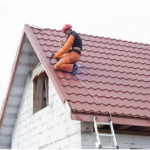Many people prefer the stability and insulation offered by sloped roofs. However, flat roofs are popular in homes and businesses. They offer many advantages. Flat roofs are extremely versatile and can increase outdoor space. A roof deck can improve property value. To protect your investment, here are some things you should consider when adding a roof deck on your business or home.
Preparation for adding a deck
You must ensure that the roof is stable before you install a roof deck. The roof deck will be heavier than a normal roof, so you must consider this before starting construction. At a minimum, the roof should be capable of supporting 55 pounds per square feet. A professional roofer will help you assess whether your flat roof is capable of supporting the materials you choose. This will save you a lot in hassle and money down the road.
Material Options
You have a variety of materials available to build your roof deck. These are some of the best features of each option.
- Vinyl decking that is waterproof: The PVC (polymerizing, vinyl chloride), decking will meet all your waterproofing and decking requirements with one product. Installing one product is easier and saves you time.
- Built-up roof: This is the traditional hot-tar and-gravel roof construction. It requires several steps. This involves the alternating of waterproof material with hot-tar. The river stone layer is then added to ballast the roof. This is one of the more affordable options but it’s also very heavy.
- Modified bitumen: The modified bitumen option can be a single-ply roof that is available in both traditional torch-down and modern peel-and stick systems. You can also choose to do it yourself with the peel-and stick method. The torch-down method can cause fire hazards and is not recommended for homes that are occupied. Modified bitumen roofs require extra preparation and product application in order to create usable deck space.
- Rubber membrane (EPDM: This rubber material is similar to an inner tube. It can be mechanically attached with fasteners or ballasted with stones. Although it is lightweight and durable, the standard black material absorbs heat.
A weak or poorly constructed roof can lead to wear and tear, severe damage or even death. Our roofing specialists can help you choose the right material for your roof. Roofs must be inspected by a professional roofing contractor. In this instance, the contractor will also need to inspect the roof. The roof below must be inspected as often as the roofing professional recommends. Decks located beneath trees will require more maintenance to remove debris than rooftop decks above high-rises.
Installing a Roof Deck
Roof decks are usually “floating” structures that rest on top of flat roofs. It is important to weatherproof the roof below deck to stop water from entering the building below. Even without roof decks, flat roofs can leak due to design mistakes, poor materials and improper installation. Roof decks can cause more serious leaking and drainage issues than they solve. A rubber watertight membrane adds extra protection. This membrane will act as an additional barrier between the floating deck materials, and the roof materials below.
For support, two-foot x six-foot sections of wood called “sleepers”, are attached to the waterproof membrane. These are added every 16 inches and serve as a support for deck materials. The deck can be easily removed if the waterproof membrane becomes damaged or needs to be repaired.
When building your roof deck, you will have many choices for materials and design. Sustainable wood and decking are a good choice for the environment. Most eco-friendly materials resist moisture and wear very well. It is important to make sure the material and design you choose are appropriate for your local climate. You should avoid certain materials that are susceptible to water damage or warping, such as wood.
It doesn’t matter what decking material you use, it is important to maintain the membrane below for cleaning and repair. Deck panels should be removable with minimum effort and damage to the membrane. You risk allowing the membrane to deteriorate if you can’t reach it. This could lead to costly problems in the future.
Permitting
You should apply for all permits necessary by your state or city before you start any major construction project. It is possible to pass if your plans comply with certain building codes, zoning regulations and structural requirements. You will receive a permit. A permit is required to be issued. There is a fee. However, without one you could face serious consequences. You and others could be at risk if you do not follow the correct steps or miss a step. You could face a fine or even be required to take down your newly constructed deck if the city discovers that you made a structural addition without a permit. Before you start planning for your roof deck, make sure to check the local permitting requirements.
This post was written by Ted Williams! Ted is the owner of https://oldtimeroofing.net, one of the best roofing companies in Saint Petersburg, FL! Ted is a Master Elite Weather Stopper GAF Roofing Contractor, a double award winner of Best Steep-Slope Contractor from GAF and achiever of Master Elite Consumer Protection Excellence from GAF. He has been serving the Pinellas County area since 1978. Old Time Roofing has a tradition of quality workmanship, servicing residential and commercial properties.


